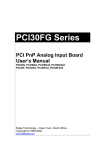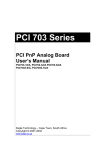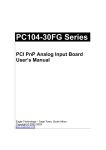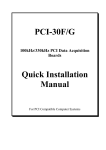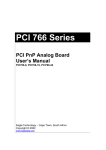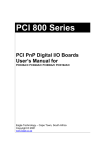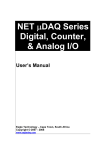Download Dynex DX-WMSE Mouse User Manual
Transcript
PCI30FG Series PCI PnP Analog Input Board User’s Manual PCI30G, PCI30GA, PCI30G32, PCI30GA32 PCI30F, PCI30FA, PCI30F32, PCI30FA32 Eagle Technology – Cape Town, South Africa Copyright © 1999-2002 www.eagledaq.com PCI30FG User Manual Analog Input Boards Data Acquisition and Process Control © Eagle Technology 31-35 Hout Street • Cape Town • South Africa Phone +27 21 423 4943 • Fax +27 21 424 4637 Email [email protected] Eagle Technology © Copyright 2002 i PCI30FG User Manual Copyright All rights reserved. No part of this publication may be reproduced, stored in a retrieval system, or transmitted, in any form or any means, electronic, mechanical, by photographing, recording, or otherwise without prior written permission. Copyright © Eagle Technology, South Africa August 2002 Revision 1.2 Information furnished in this manual is believed to be accurate and reliable; however no responsibility is assumed for its use, or any infringements of patents or other rights of third parties, which may result from its use. Trademarks and Logos in this manual are the property of their respective owners. Product Warranty Eagle Technology, South Africa, warrants its products from defect in material and workmanship from confirmed date of purchase for a period of one year if the conditions listed below are met. The product warranty will call the Eagle Technology Data Acquisition Device short as ETDAQD. • • • The warranty does not apply to an ETDAQD that has been previously repaired, altered, extended by any other company or individual outside the premises of Eagle Technology. That a qualified person configure and install the ETDAQD, and damages caused to a device during installation shall make the warranty void and null. The warranty will not apply to conditions where the ETDAQD has been operated in a manner exceeding its specifications. Eagle Technology, South Africa, does not take responsibility or liability of consequential damages, project delays, damaging of equipment or capital loss as a result of its products. Eagle Technology, South Africa, holds the option and final decision to repair or replace any ETDAQD. Proof of purchase must be supplied when requesting a repair. Eagle Technology © Copyright 2002 ii PCI30FG User Manual TABLE OF CONTENTS 1 INTRODUCTION 1 Features 1 Applications 1 Key Specifications 2 Software Support 2 2 3 INSTALLATION Package 3 Hardware Installation 3 Software Installation Windows 98 Post installation Windows NT/2000 4 4 7 8 Configuration 9 Accessories 9 3 INTERCONNECTIONS 10 External Connectors 10 Pin Assignments 10 Signal Definitions 12 Analog Input Single Ended Inputs Differential Inputs 12 12 13 Analog Output 14 Digital Input/Output 14 Counter-Timer 14 4 15 PROGRAMMING GUIDE EDR Enhanced API Eagle Technology © Copyright 2002 15 iii PCI30FG User Manual Digital Inputs/Outputs Reading the Digital Inputs Writing to the Digital Outputs 16 16 16 Counters Writing the initial counter value Reading a counter Configuring a counter 17 17 17 18 Analog Output Writing to a DAC channel 19 19 Analog Input Reading a single voltage from a channel Configuring the ADC subsystem for scanning Starting and Stopping the ADC process Getting data from the driver buffer Querying the ADC subsystem 21 21 21 23 24 24 5 26 CALIBRATION Requirements 26 Software 26 Connection 27 Variable Resistor Description 27 A/D Calibrating Procedure Calibrating the PCI30Gx series 28 28 A. SPECIFICATION 29 B. CONFIGURATION CONSTANTS 30 Query Codes 30 Error Codes 31 Digital I/O Codes 31 C. LAYOUT DIAGRAM 32 D. ORDERING INFORMATION 33 Eagle Technology © Copyright 2002 iv PCI30FG User Manual Table of Figures Figure 2-1 Add New Hardware Wizard Step1 ..................................................4 Figure 2-2 Add New Hardware Wizard Step2 ..................................................5 Figure 2-3 Add New Hardware Wizard Step3 ..................................................5 Figure 2-4 Add New Hardware Wizard Step4 ..................................................6 Figure 2-5 Add New Hardware Wizard Step5 ..................................................6 Figure 2-6 Restart Your Computer ...................................................................7 Figure 2-7 System Properties...........................................................................7 Figure 2-8 EagleDAQ .......................................................................................8 Figure 2-9 A/D Span Jumper............................................................................9 Figure 3-1 Single ended analog input ............................................................13 Figure 3-2 Differential Analog Inputs..............................................................13 Figure 4-A EDR Enhanced Design.................................................................15 Figure 6-1 A/D Calibration Connections.........................................................27 Eagle Technology © Copyright 2002 v PCI30FG User Manual Table of Tables Table 3-1 External Analog Connector - SCSI-II-50F CENT............................11 Table 3-2 Internal DIO/CT Connector – IDC-40M ..........................................11 Table 3-3 External DIO/CT Connector - DB-37M ...........................................11 Table 3-4 Signal definitions ............................................................................12 Table 4-1 Counter Assignment.......................................................................17 Table 4-2 Counter Configuration ....................................................................18 Table 6-1 VR Assignment ..............................................................................27 Table D-1 Ordering Information......................................................................33 Eagle Technology © Copyright 2002 vi PCI30FG User Manual 1 Introduction The PCI30FG series are 32-bit bit PCI bus architecture data acquisition boards. They are available in two basic models, the G and F series. They can samples at 100kHz or 330kHz respectively. Addition to analog input, they also have analog output, digital input/output and counter-timer capabilities. For this reason the PCI30FG is an excellent all purpose data acquisition device with extensive analog input capabilities. Features The PCI30FG does have some very unique features and are short listed below: • • • • • • • 32-bit PCI bus Revision 2.1 compliant 8/16 differential or 16/32 single-ended A/D inputs 2K word A/D FIFO Auto channel scanning Software controlled input ranges and gains 3 x 8-bit I/O ports 4 x 16-bit user counter-timers Applications The PCI30FG can be used in the following applications: • Voltage monitoring • Voltage control • FFT signal calculation • General process control • Frequency measurement • Pulse counting Eagle Technology © Copyright 2002 1 PCI30FG User Manual Key Specifications • • • • • • • • • A/D resolution: 12-bits D/A resolution: 12-bits DIO width: 8-bits CT width: 16-bits A/D non-linearity: less than ±0.75LSB A/D ranges: ±5V, ±10V, 0-10V A/D scan rate: 100kHz or 330kHz A/D, D/A interfaces via a 50 way SCSI right angle female centronics connector Digital I/O, Counter-timer via IDC40 Header Software Support The PCI30FG is supported by EDR Enhanced and comes with an extensive range of examples. The software will help you to get your hardware going very quickly. It also makes it easy to develop complicated control applications quickly. All operating system drivers, utility and test software are supplied on a CD-Rom. Eagle Technology © Copyright 2002 2 PCI30FG User Manual 2 Installation This chapter describes how to install and configure the PCI30FG for the first time. Minimal configuration is necessary; almost all settings are done through software. The PCI BIOS will assign an I/O base address and interrupt level. Package PCI30FG package will contain the following: • PCI30FG PCI board • EDR Enhanced Software Development Kit CD-Rom Hardware Installation This section will describe how to install your PCI30FG into your computer. • Switch off the computer and disconnect from power socket. Failure to disconnect all power cables can result in hazardous conditions, as there may be dangerous voltage levels present in externally connected cables. • • • • • • • Remove the cover of the PC. Choose any open PCI slot and insert PCI30FG. Insert bracket screw and ensure that the board sits firmly in the PCI socket. Install digital I/O connector cable. Replace the cover of the PC. Reconnect all power cables and switch the power on. The hardware installation is now completed. Eagle Technology © Copyright 2002 3 PCI30FG User Manual Software Installation Windows 98 Installing the Windows 98 device driver is a very straightforward task. Because it is plug and play Windows will detect the PCI30FG as soon as it is installed. No setup is necessary. You simply only have to supply Windows with a device driver. Wait until Windows detects the new hardware Figure 2-1 Add New Hardware Wizard Step1 Select Next Eagle Technology © Copyright 2002 4 PCI30FG User Manual Figure 2-2 Add New Hardware Wizard Step2 Select default option, search for best driver and select next Figure 2-3 Add New Hardware Wizard Step3 Select specify a location and enter the directory location of the driver on your EDR Enhanced SDK CD Rom <CDROM>\EDRE\DRIVERS\WDM\PCI30FG Select Next to proceed Eagle Technology © Copyright 2002 5 PCI30FG User Manual Figure 2-4 Add New Hardware Wizard Step4 Windows should have detected the proper driver and ready to install it. Select Next to proceed. Figure 2-5 Add New Hardware Wizard Step5 Click on the finish button to complete the installation. Click Yes to restart your computer. Eagle Technology © Copyright 2002 6 PCI30FG User Manual Figure 2-6 Restart Your Computer Post installation After your installation was complete there is a few steps that can be followed to check that your installation was successful. • • First make sure that the driver is working properly by opening the system folder in the control panel. Check under the system device list if your board is listed and working properly. See picture below. Figure 2-7 System Properties • Clearly you can see that the PCI36C is listed and working properly. Eagle Technology © Copyright 2002 7 PCI30FG User Manual • Further open the control panel and then the EagleDAQ folder. This dialog should list all installed hardware. Verify your board’s properties on this dialog. See picture below Figure 2-8 EagleDAQ Now the first part of your installation has been completed and ready to install the EDR Enhanced Software Development Kit. • Run setup.exe found on the EDR Enhanced SDK CD-Rom and follow the on screen instructions Windows NT/2000 Windows NT/2000 does not require any special setup procedure. The Windows NT driver does not support plug and play. If Windows 2000 detects a new device simply install a default driver, or so called placeholder. To install the Windows NT/2000 drivers simply run setup.exe on the EDR Enhanced CD-Rom. This will automatically install the device drivers. Restart your computer when done. Open the EagleDAQ folder in the control panel to check if your installation was successful. Figure 2-8 shows a successful installation. Eagle Technology © Copyright 2002 8 PCI30FG User Manual Configuration Only the PCI30Gx series allows one manual setting. The PCI30Gx series has one jumper, LK1, to change the voltage span. The figure below shows the two different jumper settings. Figure 2-9 A/D Span Jumper Accessories The PCI30FG does have a wide variety of accessories that it can be connected too. See chapter on accessories. Eagle Technology © Copyright 2002 9 PCI30FG User Manual 3 Interconnections The PCI30FG is designed so that there is a connector for analog signals and digital signals. The analog connector is on the bracket attached to the board and the other a connector on the PCB internal to the PC. External Connectors The PCI30FG does have two connectors, a SCSI-II-50 female centronics and an IDC40 male. The ICD40M can also be extended to the computer casing by making use of an extender cable and bracket that is supplied with the PCI30FG package. The extender cable will make the digital I/O and countertimer signals available outside the computer casing. The connector is a DB37 male. Pin Assignments The table below shows the pin assignments for the PCI30FG. Pin 1 2 3 4 5 6 7 8 9 10 11 12 13 14 15 16 Name +5V EXT TRIG DGND DAC3 DAC2 DAC1 DAC0 AGND AGND CHAN0 CHAN2 CHAN4 CHAN6 CHAN8 CHAN10 CHAN12 Pin 26 27 28 29 30 31 32 33 34 35 36 37 38 39 40 41 Name +12V -12V EXT CLK SENSE3 SENSE2 SENSE1 SENSE0 AGND AGND CHAN1 CHAN3 CHAN5 CHAN7 CHAN9 CHAN11 CHAN13 Eagle Technology © Copyright 2002 10 PCI30FG User Manual 17 18 19 20 21 22 23 24 25 CHAN14 CHAN16 CHAN18 CHAN20 CHAN22 CHAN24 CHAN26 CHAN28 CHAN30 42 43 44 45 46 47 48 49 50 CHAN15 CHAN17 CHAN19 CHAN21 CHAN23 CHAN25 CHAN27 CHAN29 CHAN31 Table 3-1 External Analog Connector - SCSI-II-50F CENT Pin 1 3 5 7 9 11 13 15 17 19 21 23 25 27 29 31 33 35 37 39 Name PA0 PA2 PA4 PA6 PB0 PB2 PB4 PB6 PC0 PC2 PC4 PC6 DGND CNT0 COUT0 CGTE1 CNT2 COUT2 +5V DGND Pin 2 4 6 8 10 12 14 16 18 20 22 24 26 28 30 32 34 36 38 40 Name PA1 PA3 PA5 PA7 PB1 PB3 PB5 PB7 PC1 PC3 PC5 PC7 CLK2 OUT2 CGTE0 CNT1 COUT1 CGTE2 DGND DGND Table 3-2 Internal DIO/CT Connector – IDC-40M Pin 1 2 3 4 5 6 7 8 9 10 11 12 13 14 15 16 17 18 19 Name PA0 PA2 PA4 PA6 PB0 PB2 PB4 PB6 PC0 PC2 PC4 PC6 DGND CNT0 COUT0 CGTE1 CNT2 COUT2 +5V Pin 20 21 22 23 24 25 26 27 28 29 30 31 32 33 34 35 36 37 Name PA1 PA3 PA5 PA7 PB1 PB3 PB5 PB7 PC1 PC3 PC5 PC7 CLK2 OUT2 CGTE0 CNT1 COUT1 CGTE2 Table 3-3 External DIO/CT Connector - DB-37M Eagle Technology © Copyright 2002 11 PCI30FG User Manual Signal Definitions This sections deal with all the signals abbreviations. Signal CHAN0-31 DAC0-3 SENSE0-3 PA0-7 PB0-7 PC0-7 CNT0-2 COUT0-2 CGTE0-2 CLK2 OUT2 Description Analog input channel Analog output channel Sensing line for analog output channel Port A on PPI Port B on PPI Port C on PPI User counter clock input User counter clock output User counter gate Internal counter input Internal counter output Table 3-4 Signal definitions OVERLOADING ANY ANALOGUE INPUT BY MORE THAN 10% MAY CAUSE OTHER INPUT CHANNELS TO BECOME INACCURATE OR NOISY. FOR PCI30FG INPUTS OPERATING AT MAXIMUM GAIN, THIS CORRESPONDS TO AN INPUT VOLTAGE OF 5.5 mV. Analog Input Analog signals are connected either as single ended or differential inputs. Single Ended Inputs With single ended inputs, connections share a common low reference that is connected to analog ground. See figure below. The advantage of such a connection is that you have a maximum number of inputs. Its major disadvantage is the loss of common mode rejection obtainable from differential mode. Single ended inputs are very sensitive to noise lead lengths should be kept as short as possible. Eagle Technology © Copyright 2002 12 PCI30FG User Manual CH0 V0 V15 CH15 AGND Figure 3-1 Single ended analog input Differential Inputs In differential input mode two multiplexer switches per channel are used. The A/D converter measures the difference in potential between the two channels. Channels are paired to form a single differential input. Channel 0 and channel 8 is used as channel 0, channels 1 and 9 etc. To connect see diagram below. It is also very important to know that each return connection must be referenced to analog ground. CH0 CH0 RET V0 V7 CH7 CH7 RET AGND Figure 3-2 Differential Analog Inputs Eagle Technology © Copyright 2002 13 PCI30FG User Manual In differential mode, all signal inputs to the PCI30FG must be referred to ground. This can be done by connecting a 1 to 10 kΣ Σ resistor from the low end of each input to ground. Analog Output The analog outputs come with sense lines and it is important to make sure that they are connected to the correct channel. If left unconnected the output will simple float at +10V or –10V. The analog output range is ±10V and is fully software configurable. The EDR Enhanced driver support auto ranging and will always select the range with the best possible resolution. For normal operation simply connect SENSE0 to DAC0. Digital Input/Output The PCI30FG has got 3x8-bit digital I/O ports that are fully configurable as inputs or outputs. The digital I/O uses a chip that is fully compatible with the Intel 8255 programmable peripheral interface. Make sure not to overload the PPI because it will cause serious damage and will need to be repaired. OVERLOADING ANY DIGITAL I/O LINE WILL CAUSE SERIOUS DAMAGE TO THE DIGITAL I/O CHIP. OPERATING OUTSIDE THE TTL VOLTAGE RANGE WILL CAUSE PERMANENT DAMAGE TO THE DIGITAL I/O CONTROL CIRCUIT. Counter-Timer There are six counter-timers on the PCI30FG of which four are available for the user. Two are used for A/D timing. The timers are compatible with the Intel 8254 counter-timer device. The 8254 counter-timer datasheets can be used as reference for configuring the counter-timer sub-system. There is no onboard clock for the user counter-timers and an external clock is required. Eagle Technology © Copyright 2002 14 PCI30FG User Manual 4 Programming Guide The PCI30FG is supplied with a complete software development kit. EDR Enhanced (EDRE SDK) comes with drivers for many operating systems and a common application program interface (API). The API also serves as a hardware abstraction layer (HAL) between the control application and the hardware. The EDRE API make it possible to write one application that can be used on all hardware with common sub-systems. The PCI30FG can also be programmed at register level, but it is not recommended. A detailed knowledge of the PCI30FG is needed and some knowledge about programming Plug and Play PCI devices. We recommend that you only make use of the software provided by Eagle Technology. EDR Enhanced API The EDR Enhanced SDK comes with both ActiveX controls and a Windows DLL API. Examples are provided in many different languages and serve as tutorials. EDRE is also supplied with a software manual and user’s guide. The EDRE API hides the complexity of the hardware and makes it really easy to program the PCI30FG. It has got functions for each basic sub-system and is real easy to learn. Figure 4-A EDR Enhanced Design Eagle Technology © Copyright 2002 15 PCI30FG User Manual Digital Inputs/Outputs The PCI30FG has 24 digital I/O lines, configured as 3 x 8-bit ports. The EDRE API supports auto direction configuration. By writing to or reading from a port, it is automatically configured as an output or input. A port is defined as a collection of simultaneous configurable entities. Thus in the case of the PCI30FG each port is only 8-bits wide. Reading the Digital Inputs A single call is necessary to read a digital I/O port. API-CALL Long EDRE_DioRead(ulng Sn, ulng Port, ulng *Value) The serial number, port, and a pointer to variable to hold the result must be passed by the calling function. A return code will indicate if any errors occurred. ACTIVEX CALL Long EDREDioX.Read(long Port) Only the port-number needs to be passed and the returned value will either hold an error or the value read. If the value is negative an error did occur. Writing to the Digital Outputs A single call is necessary to write to a digital I/O port. API-CALL Long EDRE_DioWrite(ulng Sn, ulng Port, ulng Value) The serial number, port, and a value must be passed by the calling function. A return code will indicate if any errors occurred. ACTIVEX CALL Long EDREDioX.Write(long Por, ulng Value) The port number and value to be written needs to be passed and the returned value holds an error or the value read. If the value is negative an error did occur. Eagle Technology © Copyright 2002 16 PCI30FG User Manual Counters The counter sub-system is supported by functions to Write, Read and Configure. There are 4 counters that are available to the user and are compatible with the industry standard 8254 counter-timer. The table below shows all counters and their assigned function on the board. Please note that only some are available for the user. The 8254 datasheet has more information on the counter-timer modes. Counter 0 1 2 3 4 5 Software Assigned Number N/A N/A 3 0 1 2 Description ADC clock ADC prescaler User Counter 3 User Counter 0 User Counter 1 User Counter 2 Table 4-1 Counter Assignment Writing the initial counter value A single call is necessary to write a counter’s initial load value. API-CALL Long EDRE_CTWrite(ulng Sn, ulng Ct, ulng Value) The serial number, counter-number, and a value must be passed by the calling function. A return code will indicate if any errors occurred. ACTIVEX CALL Long EDRECTX.Write(long Port, ulng Value) The port number and value to be written needs to be passed and the returned value holds an error or the value read. If the value is negative an error did occur. Reading a counter A single call is necessary to read a counter’s current value. API-CALL Long EDRE_CTRead(ulng Sn, ulng Ct, pulng Value) The serial number, counter-number, and a pointer must be passed by the calling function. A return code will indicate if any errors occurred. The value buffer will hold the value read from the counter. ACTIVEX CALL Long EDRECTX.Read(long Port) The port number needs to be passed. The returned value will either hold the error code or the value read from the counter. If negative it means an error occurred, otherwise it is the value read from the counter. Eagle Technology © Copyright 2002 17 PCI30FG User Manual Configuring a counter A single call is necessary to configure a counter. An external clock must clock the first three counters, but the internal 8MHz clock clocks the fourth counter. API-CALL Long EDRE_CTConfig(ulng Sn, ulng Ct, ulng Mode, ulng Type, ulng ClkSrc, ulng GateSrc) The serial number, counter-number, mode, type, clock source and gate source is needed to specify a counter’s configuration. A return code will indicate if any errors occurred. ACTIVEX CALL Long EDRECTX.Configure(long ct, long mode, long type, ulng source, ulng gate) The counter-number, mode, type, clock source and gate source is needed to specify a counter’s configuration. A return code will indicate if any errors occurred. Only the counter mode parameter is used by the PCI30FG. The table below shows the options for each parameter. Parameter Sn Ct Mode Type Source Gate Description Serial Number Counter Number: 0 : User Counter 0 1 : User Counter 1 2 : User Counter 2 3 : User Counter 3 8254 Counter Mode. See 8254 datasheet for details Not Used Not Used Not Used Table 4-2 Counter Configuration How to latch all counters The 8254 counters support a function where all counters can be latched at the same time. The PCI30FG driver supports this function through a query call to the driver. This will only work on the first 3 user counters. Example: Unsigned long sn=1000000001 EDRE_Query(sn,CTLATCALL=302,0) Eagle Technology © Copyright 2002 18 PCI30FG User Manual Analog Output The PCI30FG-A version has 4 x 12-bit DAC channels that support single write and signal generation. Signal generation is done form a driver buffer and use user counter 3 for timing. Signals can be generated at 5KHz. Writing to a DAC channel A single call is necessary to set a voltage on a DAC channel. API-CALL Long EDRE_DAWrite (ulng Sn, ulng Channel, long uVoltage) The serial number, DAC channel and micro-voltage is needed to set a DAC channel’s voltage. A return code will indicate if any errors occurred. ACTIVEX CALL Long EDREDAX.Write (long Channel, long uVoltage) The DAC channel and micro-voltage is needed to set a DAC channel’s voltage. A return code will indicate if any errors occurred. Generating a Waveform Generating a waveform is basically a two-step process. First configure a channel then start and stop it. The board can output signals from a driver buffer at a maximum of 5KHz per channel. Two modes are available, non-loop mode and pattern mode. The non-loop mode is will stream the values in the driver buffer only once and then stop, where pattern only resides inside the buffer. Please note that the diver buffer depth is only 1024 samples per channel. API-CALL Long EDRE_DAConfig (ulng Sn, ulng Channel, ulng Frequency, ulng ClkSrc, ulng GateSrc, ulng Continuous, ulng Length, long *uVoltage) Parameter Sn Channel Type Unsigned long Unsigned long Frequency ClkSrc GateSrc Continuous Unsigned long Unsigned long Unsigned long Unsigned long Length uVoltage Return Unsigned long Pointer to a long buffer Long Description Board’s serial number Channel 0: DAC Channel 0 1: DAC Channel 1 2: DAC Channel 2 3: DAC Channel 3 Sample output frequency ALWAYS USE USER COUNNTER 3 NOTE USED MODE 0: non-loop-mode 1: loop-mode Buffer length (1024 MAX) Buffer filled with micro voltages Error Code Eagle Technology © Copyright 2002 19 PCI30FG User Manual ACTIVEX CALL Long EDRDAX.Configure (long Channel, long Frequency, long ClkSrc, long GateSrc, long Continuous, long Length, long *uVoltage) Parameter Channel Long Frequency ClkSrc GateSrc Continuous Long Long Long Long Length uVoltage Return Type Long Pointer to a long buffer Long Description Channel 0: DAC Channel 0 1: DAC Channel 1 2: DAC Channel 2 3: DAC Channel 3 Sample output frequency ALWAYS USE USER COUNNTER 3 NOTE USED MODE 0: non-loop-mode 1: loop-mode Buffer length (1024 MAX) Buffer filled with micro voltages Error Code API-CALL Long EDRE_DAControl (ulng Sn, ulng Channel, ulng Command) Parameter Sn Channel Type Unsigned long Unsigned long Command Unsigned long Return Long Description Board’s serial number Channel 0: DAC Channel 0 1: DAC Channel 1 2: DAC Channel 2 3: DAC Channel 3 Command Code 0: NULL 1: Start process 2: Stop process Error Code ACTIVEX CALL Long EDREDAX.Control (long Channel, long Command) Parameter Channel Long Command Long Return Long Type Description Channel 0: DAC Channel 0 1: DAC Channel 1 2: DAC Channel 2 3: DAC Channel 3 Command Code 0: NULL 1: Start process 2: Stop process Error Code Eagle Technology © Copyright 2002 20 PCI30FG User Manual Analog Input The PCI30FG’s ADC subsystem is fully configurable and supports single channel reading and out scanning. While scanning a channel list and gain list can be provided. Channels are scanned in the same sequence provided in the channel list. Reading a single voltage from a channel To read a single ADC channel you need to know the voltage range and gain. API-CALL Long EDRE_ADSingle (ulng Sn, ulng Channel, ulng Gain, ulng Range, plong uVoltage) Parameter Sn Channel Gain Type Unsigned long Unsigned long Unsigned long Range Unsigned long uVoltage Return Pointer to a long Long Description Board’s serial number ADC Channel 0: Gain x 1 1: Gain x 10 2: Gain x 100 3: Gain x 1000 0: -5V to +5V, Single Ended 1: 0 to +10V, Single Ended 2: -10V to +10V, Single Ended 3: -5V to +5V, Differential 4: 0 to +10V, Differential 5: -10V to +10V, Differential Voltage read from channel Error Code ACTIVEX CALL Long EDREADX.SingleRead (long Channel) Parameter Channel Return Long Long Type Description ADC Channel Voltage returned from channel. Make sure to set the Gain and Range properties of the ADC ActiveX control. This will in turn set the range and gain when reading the ADC channel. Configuring the ADC subsystem for scanning This is the most complicated part of configuring the PCI30 for auto scanning. Make sure that you use the correct format when applying the channel list configuration. There are many loopholes and care should be taken when implementing code to configure the PCI30. API-CALL Long EDRE_ADConfig (ulng Sn, pulng Freq, ulng ClkSrc, ulng Burst, ulng Range, pulng ChanList, pulng GainList, ulng ListSize) The following parameters must be specified when configuring the ADC subsystem. Eagle Technology © Copyright 2002 21 PCI30FG User Manual Parameter Sn Freq ClkSrc Burst Type Unsigned long Pointer to an unsigned long Unsigned long Unsigned long Unsigned long Range ChanList GainList ListSize Pointer to an unsigned long Pointer to an unsigned long Unsigned long Description Board’s serial number. Sampling frequency. The actual sampling frequency will be returned with this parameter. 0: Internal and to External Gate 1: Internal 2: External Clock 3: External Clock and Gate 0: Normal Mode 1: Burst Mode 0: -5V to +5V, Single Ended 1: 0 to +10V, Single Ended 2: -10V to +10V, Single Ended 3: -5V to +5V, Differential 4: 0 to +10V, Differential 5: -10V to +10V, Differential This is an array of unsigned longs that contains the gains of channels to be sampled when scanning the ADC sub-system. The max size of the channel list is 64. This is an array of unsigned longs that contains the channels to be sampled when scanning the ADC sub-system. The max size of the channel list is half the FIFO depth. This parameter determines the length the two previous arrays. This is also the depth of the channel list that is programmed to the board. ACTIVEX CALL Long EDREADX.Configure (plong Channels, plong Gains, long ListSize) Parameter Type Description Channels Pointer to This is an array of unsigned longs that contains the gains of channels to be an unsigned sampled when scanning the ADC sub-system. The max size of the channel list is long half the FIFO depth. Gains Pointer to This is an array of unsigned longs that contains the channels to be sampled when an unsigned scanning the ADC sub-system. The max size of the channel list is half the FIFO long depth. ListSize Unsigned This parameter determines the length the two previous arrays. This is also the long depth of the channel list that is programmed to the board. The range code does not apply to the S models, for the are always differential and bipolar. The Frequency and ClockSource ADC ActiveX control must be setup before calling the configure function. EDREADX.Frequency Frequency The ADC sampling frequency Eagle Technology © Copyright 2002 22 PCI30FG User Manual WARNING!! In normal sampling mode channels are sampled sequentially according to the given channels list. The time spacing between each channel is the same as the frequency in normal mode. The maximum frequency is the same as the maximum speed of the board. In burst mode the all channels in the channel list is converted as fast as possible (depends on the A/D converter speed) every period. The period is the same as the sampling frequency. The maximum sampling frequency is the maximum frequency of the board divided by the number of channels in the channel list. Frequency Example: Normal Mode Frequency = 100 000 Hz Channel List Length = 10 Time = 10 uS Time between channels = 10 uS Burst Mode Max of Board = 100 000 Hz Frequency = 20 000 Hz Channel List Length = 10 Max Frequency = 2 000 Hz Time = 500 uS Time between channels = 10 uS (ADC Rating) Time between sets = 50 uS EDREADX.ClockSource ClockSource 0: Internal and to External Gate 1: Internal 2: External Clock 3: External Clock and Gate Starting and Stopping the ADC process A single call is necessary to start or stop the ADC process API-CALL Long EDRE_ADStart (ulng Sn) Parameter Sn Return Type Unsigned long Long Description Board’s serial number Error Code ACTIVEX CALL Eagle Technology © Copyright 2002 23 PCI30FG User Manual Long EDREADX.Start () Parameter Return Long Type Description Error Code API-CALL Long EDRE_ADStop (ulng Sn) Parameter Sn Return Type Unsigned long Long Description Board’s serial number Error Code ACTIVEX CALL Long EDREADX.Stop () Parameter Return Long Type Description Error Code Getting data from the driver buffer A single call is necessary copy data from the driver buffer to the user buffer. API-CALL Long EDRE_ADGetData (ulng Sn, plong Buf, pulng BufSize) Parameter Sn Buf BufSize Return Type Unsigned long Pointer to a long buffer. Pointer to an unsigned long Long Description Board’s serial number Buffer to copy micro voltages too. Size of buffer must be passed or number of samples requested. The returned value will indicate the number of actual samples copied to the buffer. Error Code ACTIVEX CALL Long EDREADX.GetData (plong Buffer, plong Size) Parameter Buf BufSize Type Pointer to a long buffer. Pointer to a long Return Long Description Buffer to copy micro voltages too. Size of buffer must be passed or number of samples requested. The returned value will indicate the number of actual samples copied to the buffer. Error Code Querying the ADC subsystem The driver can be queried to check the status of the ADC subsystem. The number of unread samples is one example. Eagle Technology © Copyright 2002 24 PCI30FG User Manual API-CALL Long EDRE_Query (ulng Sn, ulng QueryCode, ulng Param) Parameter Sn QueryCode Type Unsigned long Unsigned long Param Return Unsigned long Long Description Board’s serial number Query code. See appendix Example: ADUNREAD: This will tell you the number of available samples. ADBUSY: Is the ADC subsystem busy? Extra parameter. Returned query code ACTIVEX CALL Long EDREADX.GetUnread () Parameter Return Long Type Description Number of samples available in the driver. This function automatically queries the ADC driver buffer for the number of available samples. Eagle Technology © Copyright 2002 25 PCI30FG User Manual 5 Calibration This chapter contains information to calibrate the A/D and D/A sub-systems of the PCI30FG. The PCI30FG is calibrated during the manufacturing test and therefore does not require recalibration under normal conditions. However under extreme conditions or to optimize accuracy, the board needs to be recalibrated. Allow the host PC and the board to warm up for at least one hour before calibration. Requirements 1. Precision voltage source. Range +10V to –10V, with an absolute accuracy better than 0.005%, resolution 100nV or better. 2. Precision digital multimeter with ±10V range, absolute accuracy better than 0.0005%, resolution 100nV or better. 3. Calibration software. This is supplied with the software package. 4. Calibration is only done on channel 1. 5. Use the recommended connector wiring as in figure 7.1. 6. Calibration is performed with the board jumpered into its intended operating mode. 7. Use screened cable and make them as short as possible to reduce noise and loss. Software A special software program is required to calibrate the PCI30FG. This software program comes with the PCI30FG and can be found on the EDR Enhanced Software CD. The software is located in the utils/pci30fg directory. Eagle Technology © Copyright 2002 26 PCI30FG User Manual The program runs under dos and make sure that you do not run it in a Windows command box or on Windows NT. Follow the on screen instructions or the directions in the calibration section. Connection Figure 7.1 shows the connection diagram for calibrating your PCI30FG. It is very important that channels that are not used be grounded to analog ground. Also make sure that your voltage source is in perfect working order, because the accuracy of the board will depend on the accuracy of you calibration equipment. Figure 5-1 A/D Calibration Connections Variable Resistor Description Below is a table that shows the function of each pot on the PCI30FG. Only a few are used at a time depending on the version of PCI30FG. Pot VR1 VR2 VR3 VR4 VR5 VR6 VR7 VR8 VR9 Description A/D OpAmp offset pot – F&G Version A/D Bipolar offset pot – G Version A/D Monopolar offset pot G Version, Bipolar F(±5V) D/A Reference Voltage A/D Bipolar gain pot – G Version A/D Monopolar gain pot – G Version A/D Bipolar gain pot – F Version (±5V) A/D Bipolar gain pot – F Version (±10V) A/D Bipolar offset pot – F Version (±10V) Table 5-1 VR Assignment Eagle Technology © Copyright 2002 27 PCI30FG User Manual A/D Calibrating Procedure Calibrating the PCI30Gx series Bipolar Mode 1. Adjust A/D for maximum gain (ie. 1000) and apply 0.00mV to channel 1. All other channels must be connected to analog ground. Adjust VR1, the instrumentation amplifier offset pot, for 800H. 2. Set A/D for a gain of 1 and apply (-FS+2LSB) to channel 1 (ie.-4.9988V for Eagle Technology © Copyright 2002 28 PCI30FG User Manual A. Specification Specifications where not available on day of print. Please visit our website or request a product datasheet from us. Eagle Technology © Copyright 2002 29 PCI30FG User Manual B. Configuration Constants Query Codes Name APIMAJOR APIMINOR APIBUILD APIOS APINUMDEV BRDTYPE BRDREV BRDYEAR BRDMONTH BRDDAY BRDSERIALNO DRVMAJOR DRVMINOR DRVBUILD ADNUMCHAN ADNUMSH ADMAXFREQ ADBUSY ADFIFOSIZE ADFIFOOVER ADBUFFSIZE ADBUFFOVER ADBUFFALLOC ADUNREAD ADEXTCLK ADEXTTRIG ADBURST ADRANGE DANUMCHAN D3AMAXFREQ DABUSY DAFIFOSZ CTNUM CTBUSY DIONUMPORT DIOQRYPORT DIOPORTWIDTH INTNUMSRC Value 1 2 3 4 5 10 11 12 13 14 15 20 21 22 100 101 102 103 104 105 106 107 108 109 110 111 112 113 200 201 202 203 300 301 400 401 402 500 Eagle Technology © Copyright 2002 Description Query EDRE API major version number. Query EDRE API minor version number. Query EDRE API build version number. Query EDRE API OS type. Query number of devices installed. Query a board’s type. Query a board’s revision. Query a board’s manufactured year. Query a board’s manufactured month. Query a board’s manufactured day. Query a board’s serial number. Query a driver’s major version number. Query a driver’s minor version number. Query a driver’s build version number. Query number of ADC channel. Query number of samples-and-hold channels. Query maximum sampling frequency. Check if ADC system is busy. Get ADC hardware FIFO size. Check for FIFO overrun condition. Check software buffer size. Check for circular buffer overrun. Check if software buffer is allocated. Get number of samples available. Get status of external clock line – PCI30FG. Get status of external trigger line – PCI30FG. Check if burst mode is enabled. Get ADC range. Query number of DAC channels. Query maximum DAC output frequency. Check if DAC system is busy. Get DAC FIFO size. Query number of counter-timer channels. Check if counter-timer system is busy. Query number of digital I/O ports. Query a specific port for capabilities. Get a specific port’s width. Query number of interrupts sources. 30 PCI30FG User Manual INTSTATUS INTBUSCONNECT INTISAVAILABLE INTNUMTRIG 501 502 503 504 Queries interrupt system’s status. Connect interrupt system to bus. Check if an interrupt is available. Check number times interrupted Error Codes Name EDRE_OK EDRE_FAIL EDRE_BAD_FN EDRE_BAD_SN EDRE_BAD_DEVICE EDRE_BAD_OS EDRE_EVENT_FAILED EDRE_EVENT_TIMEOUT EDRE_INT_SET EDRE_DA_BAD_RANGE EDRE_AD_BAD_CHANLIST EDRE_BAD_FREQUECY EDRE_BAD_BUFFER_SIZE EDRE_BAD_PORT EDRE_BAD_PARAMETER EDRE_BUSY EDRE_IO_FAIL EDRE_BAD_ADGAIN EDRE_BAD_QUERY EDRE_BAD_CHAN EDRE_BAD_VALUE EDRE_BAD_CT EDRE_BAD_CHANLIST EDRE_BAD_CONFIG EDRE_BAD_MODE EDRE_HW_ERROR EDRE_HW_BUSY EDRE_BAD_BUFFER EDRE_REG_ERROR EDRE_OUT_RES EDRE_IO_PENDING Value 0 -1 -2 -3 -4 -5 -6 -7 -8 -9 -10 -11 -12 -13 -14 -15 -16 -17 -18 -19 -20 -21 -22 -23 -24 -25 -26 -27 -28 -29 -30 Description Function successfully. Function call failed. Invalid function call. Invalid serial number. Invalid device. Function not supported by operating system. Wait on event failed. Event timed out. Interrupt in use. DAC value out of range. Channel list size out of range. Frequency out of range. Data passed by buffer incorrectly sized Port value out of range. Invalid parameter value specified. System busy. IO call failed. ADC-gain out of range. Query value not supported. Channel number out of range. Configuration value specified out of range. Counter-timer channel out of range. Channel list invalid. Configuration invalid. Mode not valid. Hardware error occurred. Hardware busy. Buffer invalid. Registry error occurred. Out of resources. Waiting on I/O completion Digital I/O Codes Name DIOOUT DIOIN DIOINOROUT DIOINANDOUT 0 1 2 3 Value Eagle Technology © Copyright 2002 Description Port is an output. Port is an input. Port can be configured as in or out. Port is an input and an output. 31 PCI30FG User Manual C. Layout Diagram Eagle Technology © Copyright 2002 32 PCI30FG User Manual D. Ordering Information For ordering information please contact Eagle Technology directly or visit our website www.eagle.co.za. They can also be emailed at [email protected]. PCI 30-G PCI 30-GA Board PCI 30-G32 PCI 30-GA32 PCI 30-F PCI 30-FA PCI 30-F32 PCI 30-FA32 Description 16 Channel analog input board @ 100 KHz 16 Channel analog input and 4 channel analog output board @ 100 KHz 32 Channel analog input board @ 100KHz 32 Channel analog input and 4 channel analog output board @ 100 KHz 16 Channel analog input board @ 330 KHz 16 Channel analog input and 4 channel analog output board @ 330 KHz 32 Channel analog input board @ 330 KHz 132 Channel analog input and 4 channel analog output board @ 330 KHz Table D-1 Ordering Information Please visit our website to have a look at our wide variety of data acquisition products and accessories. Eagle Technology © Copyright 2002 33








































